About the Church
 |
 |
 |
 |
 |
 |
 |
The Holy Mass - Part X
Mass of the Faithful:
From the Oblation to the Hosanna
The best means of honoring Our Lady and the Saints is to offer the Holy Sacrifice of the Mass to the Triune God for their glory. The last article looked at the Offertory up to the Washing of Hands. What follows here is the continuation up to the Hosanna, or start of the Canon, the heart of the Mass.
The Suscipe, oblation to the Holy Trinity
Having finished the 25th Psalm, the priest turns to the center of the altar and, bowing down with hands joined, entreats the Most Blessed Trinity to receive the oblation that he is about to offer. He raises his eyes for a moment to the Crucifix enthroned on the altar; then with bowed head, he makes this offering of the gifts to the Most Blessed Trinity saying:

The entire offering is summed up in this beautiful prayer when the priest is turned to the Triune God and to the Church Triumphant. The priest begs the Holy Trinity to receive the offerings of bread and wine that are to be transubstantiated into the Body, Blood, Soul and Divinity of Our Lord Jesus in honor of His Passion, Resurrection and Ascension and of the Blessed Virgin Mary, St. John the Baptist, Sts. Peter and Paul and of all the Saints.
It is worthy of note that, first of all, we recall the memory of Our Lord and, then, of Our Blessed Lady, who raised far above all the others, for, as Dom Gueranger aptly states: "Our Lady, although a mere human creature, is raised far above them all … she forms a world apart." (1)
After reciting the Suscipe, the priest bends and kisses the altar as to honor Our Lord and then turns to the faithful, extends and rejoins his hands, saying “Orate Fratres” [Pray brethren]. Turning to the altar, he finishes the prayer saying silently:
One of the greatest graces granted – offered only to Catholics at a valid Mass – is that the privilege of offering to the Triune God the sacred and sublime Sacrifice of the Mass is not the prerogative of Priests alone, but belongs to the laity as well. St. Peter lays stress on this when he says “You are a chosen generation, a kingly priesthood, a holy nation, a purchased people” (Pt 2:9). (2)
The Council of Trent teaches that, by hearing Holy Mass, the merits of Our Lord Jesus Christ, the fruits of His Life, Passion and Death are bestowed upon us. We can do nothing better at the Holy Mass than to make an act of oblation to Christ that can pay some of the price for the remission of the temporal punishment due to sin and for the relief of suffering souls in Purgatory. Making sincere oblations during the Holy Mass is a glorious prerogative and enables us to acquire eternal riches.
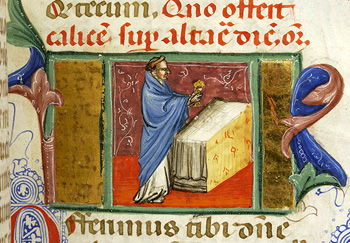
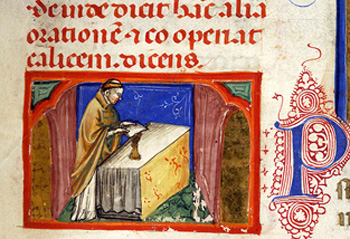
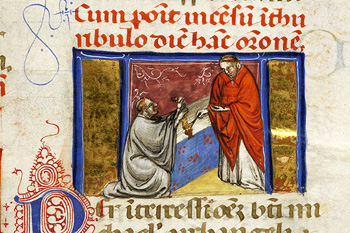 After calling upon the faithful to unite their prayers with his, the priest prays in silence with outstretched hands the special Offertory prayer called the “Secret.” This is a prayer of Petition, where we ask God to deign to accept the oblation or to implore special graces needed for our eternal salvation. (3)
After calling upon the faithful to unite their prayers with his, the priest prays in silence with outstretched hands the special Offertory prayer called the “Secret.” This is a prayer of Petition, where we ask God to deign to accept the oblation or to implore special graces needed for our eternal salvation. (3)
The modern notion that, prior to the Vatican II Novus Ordo Mass, the people were not part of the Mass is a falsehood. As Dom Gueranger remarks: "In fact, the priest never says anything in the Holy Sacrifice without the assent of the faithful, who, as we have already, noticed , participate in the priesthood." (4) This is the correct understanding of the term. Although this part of the Mass is said silently, the assent of the faithful is present in the response, "Amen."
The Preface
Next, the priest joins his hands and then disjoins them, places his right hand on the altar and, with his left hand turns to the solemn prayer, the “Preface.” (5)
The “Preface” is a beautiful hymn of praise and thanksgiving to God and dates from the time of the Apostles, as it is always found in the most ancient liturgies. At the end of the Secret, the Priest says in audible voice:
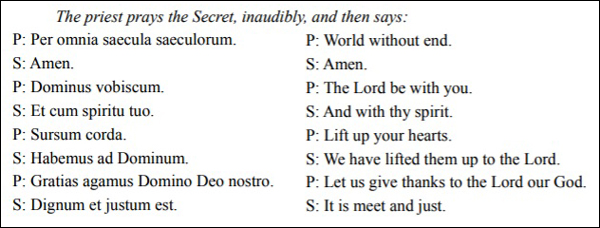
Here again, the faithful, through the server, unite themselves wholly with the words the priest is about to speak. (6)
The priest extends his hands and solemnly continues. (7)

The words “semper et ubique” [always and everywhere] emphasizes the universality of the Holy Mass. In most other Prefaces the term “Per Christum Dominum nostrum" [Through Christ Our Lord] is said, signifying the Divine seal impressed upon the humble petition of man.
The Sanctas
At the close of the Preface, the priest entreats God to permit us to join our feeble voices with choirs of Angels that cease not to proclaim:

As the “Sanctas” starts, the priest joins his hands and inclines moderately. The bell is rung three times. At the words “Benedictus qui venit” [blessed be the One who comes], the priest stands erect and makes the Sign of the Cross; at the words “Hosanna in excelsis” [Glory in the highest Heaven], he joins his hands again. At the sound of the bell, the faithful kneel as the priest recites the Sanctas.
The Trisagion (from agios (holy) and tres (three) = three times holy). It is what the Angels sing to celebrate the sanctity of the Triune God. It is the hymn heard by Isaias when favored with a vision of Heaven, and later by St. John the Disciple (Apoc 4:8).
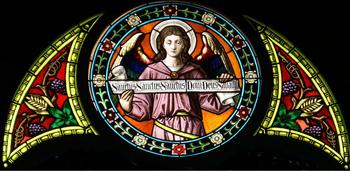 This superlative angelic cry is said by the priest to praise Deus Sabaoth, the God of Armies. What can be more appropriate than to praise the sanctity and strength of God Almighty. Indeed, Heaven and earth are full of His glory! This magnificent Trisagion - so rich in meaning - is found in every liturgy of all the rites.
This superlative angelic cry is said by the priest to praise Deus Sabaoth, the God of Armies. What can be more appropriate than to praise the sanctity and strength of God Almighty. Indeed, Heaven and earth are full of His glory! This magnificent Trisagion - so rich in meaning - is found in every liturgy of all the rites.
Hosanna is a Hebrew word meaning ‘Save us we pray.’ Hosanna in excelsis was the cry exclaimed by the Jews on the triumphant entry of Christ into Jerusalem on Palm Sunday (Mt 21:8,9). These words of praise were sung by the Angels on His entrance into the world; they were cried by the Jews on his triumphant entry into Jerusalem; (8) now they are proclaimed as the Prelude to the Canon of the Mass, the essence of the Holy Sacrifice.
Continued

The Suscipe, oblation to the Holy Trinity
Having finished the 25th Psalm, the priest turns to the center of the altar and, bowing down with hands joined, entreats the Most Blessed Trinity to receive the oblation that he is about to offer. He raises his eyes for a moment to the Crucifix enthroned on the altar; then with bowed head, he makes this offering of the gifts to the Most Blessed Trinity saying:

The entire offering is summed up in this beautiful prayer when the priest is turned to the Triune God and to the Church Triumphant. The priest begs the Holy Trinity to receive the offerings of bread and wine that are to be transubstantiated into the Body, Blood, Soul and Divinity of Our Lord Jesus in honor of His Passion, Resurrection and Ascension and of the Blessed Virgin Mary, St. John the Baptist, Sts. Peter and Paul and of all the Saints.
It is worthy of note that, first of all, we recall the memory of Our Lord and, then, of Our Blessed Lady, who raised far above all the others, for, as Dom Gueranger aptly states: "Our Lady, although a mere human creature, is raised far above them all … she forms a world apart." (1)
After reciting the Suscipe, the priest bends and kisses the altar as to honor Our Lord and then turns to the faithful, extends and rejoins his hands, saying “Orate Fratres” [Pray brethren]. Turning to the altar, he finishes the prayer saying silently:
Oráte fratres: ut meum ac vestrum sacrificium acceptábile fiat apud Deum Patrem omnipoténtem. | Pray, brethren, that my Sacrifice and yours may be acceptale to God the Father Almighty. |
One of the greatest graces granted – offered only to Catholics at a valid Mass – is that the privilege of offering to the Triune God the sacred and sublime Sacrifice of the Mass is not the prerogative of Priests alone, but belongs to the laity as well. St. Peter lays stress on this when he says “You are a chosen generation, a kingly priesthood, a holy nation, a purchased people” (Pt 2:9). (2)
The Council of Trent teaches that, by hearing Holy Mass, the merits of Our Lord Jesus Christ, the fruits of His Life, Passion and Death are bestowed upon us. We can do nothing better at the Holy Mass than to make an act of oblation to Christ that can pay some of the price for the remission of the temporal punishment due to sin and for the relief of suffering souls in Purgatory. Making sincere oblations during the Holy Mass is a glorious prerogative and enables us to acquire eternal riches.

Offertory depictions from a medieval manuscript

Below, blessing the incense for a High Mass

The modern notion that, prior to the Vatican II Novus Ordo Mass, the people were not part of the Mass is a falsehood. As Dom Gueranger remarks: "In fact, the priest never says anything in the Holy Sacrifice without the assent of the faithful, who, as we have already, noticed , participate in the priesthood." (4) This is the correct understanding of the term. Although this part of the Mass is said silently, the assent of the faithful is present in the response, "Amen."
The Preface
Next, the priest joins his hands and then disjoins them, places his right hand on the altar and, with his left hand turns to the solemn prayer, the “Preface.” (5)
The “Preface” is a beautiful hymn of praise and thanksgiving to God and dates from the time of the Apostles, as it is always found in the most ancient liturgies. At the end of the Secret, the Priest says in audible voice:

Here again, the faithful, through the server, unite themselves wholly with the words the priest is about to speak. (6)
The priest extends his hands and solemnly continues. (7)

The words “semper et ubique” [always and everywhere] emphasizes the universality of the Holy Mass. In most other Prefaces the term “Per Christum Dominum nostrum" [Through Christ Our Lord] is said, signifying the Divine seal impressed upon the humble petition of man.
The Sanctas
At the close of the Preface, the priest entreats God to permit us to join our feeble voices with choirs of Angels that cease not to proclaim:

As the “Sanctas” starts, the priest joins his hands and inclines moderately. The bell is rung three times. At the words “Benedictus qui venit” [blessed be the One who comes], the priest stands erect and makes the Sign of the Cross; at the words “Hosanna in excelsis” [Glory in the highest Heaven], he joins his hands again. At the sound of the bell, the faithful kneel as the priest recites the Sanctas.
The Trisagion (from agios (holy) and tres (three) = three times holy). It is what the Angels sing to celebrate the sanctity of the Triune God. It is the hymn heard by Isaias when favored with a vision of Heaven, and later by St. John the Disciple (Apoc 4:8).

With the angels, we join in praise Deus Sabaoth at the Sanctas
Hosanna is a Hebrew word meaning ‘Save us we pray.’ Hosanna in excelsis was the cry exclaimed by the Jews on the triumphant entry of Christ into Jerusalem on Palm Sunday (Mt 21:8,9). These words of praise were sung by the Angels on His entrance into the world; they were cried by the Jews on his triumphant entry into Jerusalem; (8) now they are proclaimed as the Prelude to the Canon of the Mass, the essence of the Holy Sacrifice.
Continued
- Dom Gueranger, Explanation of the Holy Mass, p. 84
- Ibid, p. 88
- The “Secret” varies according to the feast or ecclesiastical season and agrees in number with other changeable parts of the Mass.
- Dom Gueranger, Explanation of the Holy Mass, pp. 89-90
- In the Roman Tridentine Mass, there are 15 Prefaces: Christmas, Epiphany, Lent, Passion and Holy Cross, Easter, Ascension, Pentecost, Most Holy Trinity, Sacred Heart, Christ the King, Feasts of Blessed Virgin Mary, Feasts of St. Joseph, Feasts of the Apostles, Masses for the Dead and Common Preface, if there is no proper.
- Dom Gueranger, Explanation of the Holy Mass, p. 91.
- This is Preface #1 of Christmas and is the same as that for Corpus Christi.
- The multitudes that preceded Him were the succession of Patriarchs and the just of the Old Testament through 40 centuries, and the multitudes that followed Him are the martyrs and Saints, the confessors and virgins following one another through 20 centuries to the present day.

Posted October 9, 2017














